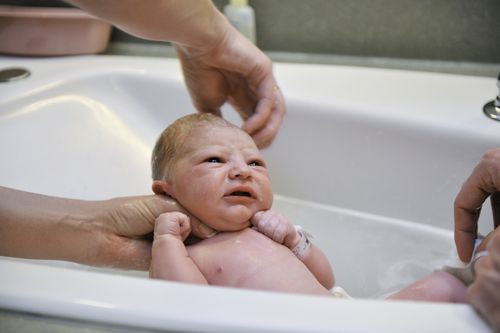Water Birth Risks: Newborns Could Inhale Poo And End Up With Some Pretty Bad Infections, Medical Groups Say

The idea of delivering a baby in a giant tub of water was once viewed as radical, but water births have risen in popularity and have become an option embraced by many expectant mothers. Although supporters of underwater births have argued women experience less pain, need less anesthesia, and have shorter labor, doctors' groups strongly advise mothers to think twice before giving birth in a tub. According to a report by the American Academy of Pediatrics (AAP) and the American College of Obstetricians and Gynecologists (ACOG), water births may increase the chances of newborns inhaling fecal matter, drowning, breathing problems, and infections.
"Many labor and delivery units are equipped with tubs to be used by laboring women, and immersion in water for relaxation and pain relief is appealing to some,” said Dr. Jeffrey L. Ecker, chair of the College’s Committee on Obstetric Practice that developed the Committee Opinion, in the press release. “But it is important to recognize that laboring in water is not the same as delivering underwater.” Laboring in a tub or hot tub is recommended by doctors as it can alleviate, and even shorten labor symptoms, which is good for the baby. However, the benefits of water births are unproven and do present the risk of rare but serious consequences for the baby’s health.
During the first stages of labor, immersion in water can help mothers feel more at ease and in control of going into labor. This is found to be associated with less use of epidurals and other forms of anesthesia, and a shorter labor, says the American Pregnancy Association. When it comes time for delivery, some women decide to get out the tub, while others decide to stay in the water for the delivery as well. The theory behind water birth is since the baby has already been in the amniotic fluid sac for nine months, giving birth in a similar environment would be gentler for the baby, and less stressful for the mother.
Although home births are evidently on the rise, statistics on how many women in the U.S. choose to undergo water births are not available since the practice isn’t measured as part of routine birth statistics. In the AAP and ACOG report, data on recent studies on alternative birthing methods, found midwife-assisted home births can be more deadly than midwife-assisted hospital births. This finding led the doctors' groups to conclude delivering in a hospital center is safer for these women.
"There are rare risks associated with [water births], especially if the baby is actually delivered in the water," said Dr. Tonse Raju, chief of the pregnancy and perinatology branch at the National Institute of Child Health and Human Development, who was involved with the recommendations, according to LiveScience. He believes mothers should be aware of these risks and think twice before opting to have a water birth, especially at home. Raju refutes the theory behind home births and says a baby’s reflex that prevents them from inhaling water could be overridden.
While there is no evidence that delivering a baby in water is safe or beneficial for the mother or the baby, the doctors groups did acknowledge the potential for rare, but serious risks of practicing immersion in the second stage of labor, or underwater delivery. In some instances, water births have led to infant drowning, breathing problems due to inhaled water, infections, and even inhaling fecal matter. It is known that babies can inhale fecal matter while in the womb if it is produced in the intestines of a fetus before birth. Stress can cause the baby to gasp inside the mother’s uterus and inhale, or aspirate amniotic fluid into his or her lungs — and if meconium is present in the amniotic fluid — this can lead to meconium aspiration syndrome (MAS), says Healthline.
Due to the lack of known benefits and the potential serious risks of water births, the report suggests "the practice of immersion in the second stage of labor (underwater delivery) should be considered an experimental procedure," and should only be performed in the mother is part of a clinical trial. Mothers who are interested in using water-based methods should only use it for the early stages of delivery and assess that the birthing facility keeps the tubs clean, and has a program to monitor the labor. Otherwise, underwater delivers should be strictly done during trials where the mothers are informed about the potential risks and possible benefits of the procedure.
Source: Immersion in Water During Labor and Delivery. AAP and ACOG. Pediatrics. 2014.
Published by Medicaldaily.com



























